* 12:25 21 January 2009 by Colin
Barras
* For similar stories, visit the Energy
and Fuels, Weapons
Technology and The
Nuclear Age Topic Guides
An old glass jar inside a beaten up old safe
at the bottom of a waste pit may seem an unlikely place to find a pivotal
piece of 20th century history. But that's just where the first batch of
weapons-grade plutonium ever made has been found - abandoned at the world's
oldest nuclear processing site.
The potentially dangerous find was made at
Hanford, Washington State, the site of a nuclear
reservation, established in 1943 to support the US's pioneering nuclear
weapons program.
Hanford made the plutonium-239
for Trinity,
the first ever nuclear weapon test, on 16 July 1945. Just three weeks later,
more Hanford plutonium was used in the nuclear strikes on the Japanese
cities of Hiroshima and Nagasaki.
But sloppy work by the contractors running
the site saw all kinds of chemical and radioactive waste indiscriminately
buried in pits underground over the 40 years Hanford was operational, earning
it the accolade of the dirtiest
place on Earth.
Nuclear archaeology
In 2004, clean-up work uncovered a battered,
rusted, and broken old safe containing a glass jug inside which was 400
millilitres of plutonium (voir Note
!)
Recent tests by Jon Schwantes' team at the
Pacific
Northwest National Laboratory in Richland, Washington, has shown this
plutonium was the first ever processed at the site, and the first made
on a usable scale anywhere in the world.
Schwantes and colleagues used the fact that
plutonium naturally decays to uranium to date the sample to 1946, give
or take 4.5 years, by comparing the amounts of the two metals present inside
the jug. Its age allowed the team to establish that the plutonium must
have come from one of four reactors - out of 11 in the US at the time -
from which fuel was reprocessed into plutonium.
Three of those reactors were on the Hanford
site, with the fourth at Oak Ridge in Tennessee. Comparing the minor plutonium
isotopes in the sample to signatures for each of the four reactors showed
that the sample came from the X-10
reactor at Oak Ridge.
Historical find
But only trawling through records at Hanford
helped Schwantes and his team realise the historical significance of their
find. The Hanford site's reprocessing plant, the first in the world, was
completed before the reactors nearby were ready, in late 1944. So the inaugural
run of the reprocessor on 9 December 1944 used fuel shipped from Oak Ridge.
"The very next run [and all subsequent
runs] used Hanford plutonium," says Schwantes. "We have the oldest
known sample of plutonium-239 - weapons plutonium."
His team read that a safe matching the description
of the one unearthed in 2004 was sealed in 1945 because of radioactive
contamination. It was disposed of in 1951, and remained lost for the next
50 years.
"The contamination was not from the plutonium
jug," Schwantes says. "The jug was intact when found."
Plutonium-239 has a half-life of 24,110 years
and emits alpha particles that are too bulky to penetrate even skin or
paper. It is most dangerous when inhaled as a dry powder, where its decay
in the lungs can cause cancer, he adds.
Bomb mystery
John
Simpson, an expert on nuclear history at Southampton University in
the UK, thinks the new find is important.
"From the historical records, it looks
as if they've got it right," he says. "But the puzzling thing is,
why didn't this plutonium make it into the bomb?" In 1944, the Americans
were working flat out to develop a nuclear capability - it's strange that
any first large batch of plutonium-239 should be stored and not used, he
says.
Schwantes thinks that is because of the radioactive
contamination to the safe it was being stored in. The first batch would
eventually have been folded back into the stockpile if not for that contamination.
But despite its historic significance, Schwantes
doesn't plan to put the sample in a museum. He is working with New
Brunswick Labs to create a standard reference sample for plutonium-239
from the material, partly because of it's primacy as the oldest sample.
"The other factor is its extreme purity - 99.96% plutonium-239 is as
pure a sample of 239 I have seen produced from any reactor," says Schwantes.
Journal reference: Analytical
Chemistry (DOI: 10.1021/ac802286a)
See
a gallery of images of the find and where it came from
World's
oldest weapons-grade plutonium found in a ditch
Plutonium-239 found inside a broken, rusty
safe has been shown to be of historic significance: dating from December
1944 it is the very first weapons-grade plutonium refined at the site,
or anywhere in the world.
The find was made at the Hanford Site, Washington
State, which supplied the US nuclear weapon program from its beginnings
until the 1980s. The site is dangerously contaminated by radioactive waste
indiscriminately buried underground over years. |
Photos documentaires
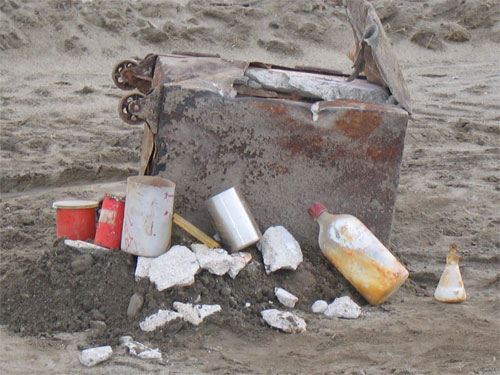
The large, stained, glass bottle to the right was found inside this
rusty safe, and contains a sample of the first weapons-grade plutonium
ever purified.
(Image: Washington Closure Hanford)
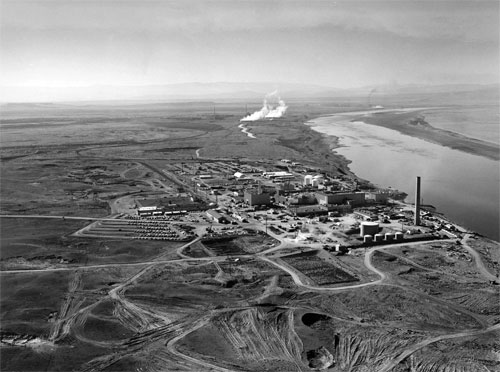
The Hanford Site in its heyday, January 1960.
(Image: US Department of Energy/Wikimedia Commons)
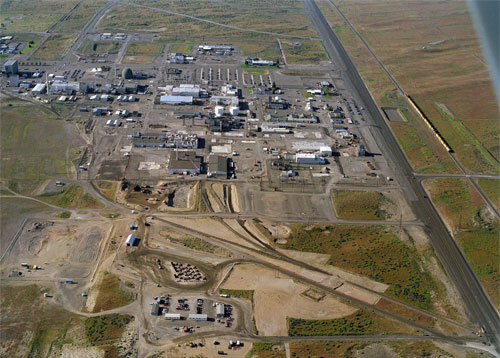
Hanford from the air today.
(Image: Washington Closure Hanford)
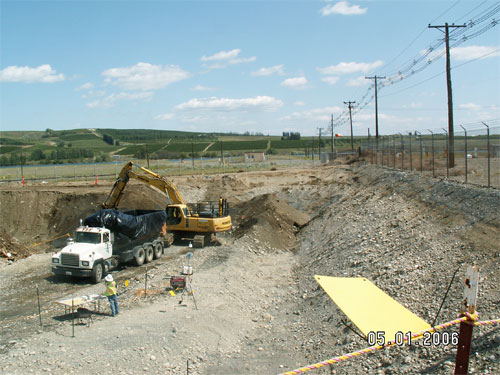
Over the last 20 years, the site has been subject to a major clean-up
operation to reduce the level of radioactive contamination.
(Image: Washington Closure Hanford)
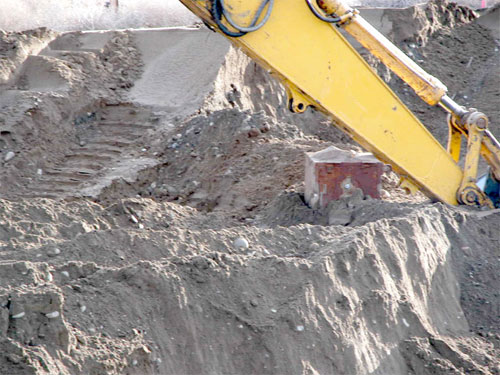
The old safe was first uncovered in 2004 by excavations that formed
part of that clean-up operation.
(Image: Washington Closure Hanford)
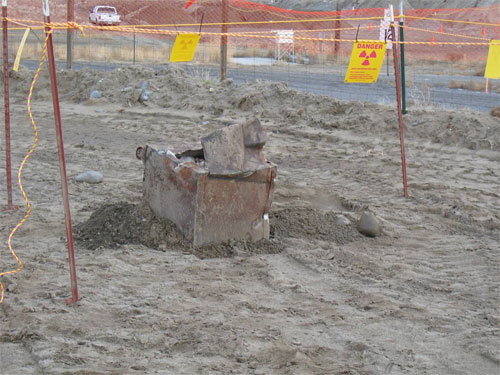
A search through Hanford's archives revealed that the safe was buried
in 1951, a few years after it had been sealed because of radioactive contamination.
(Image: Washington Closure Hanford)
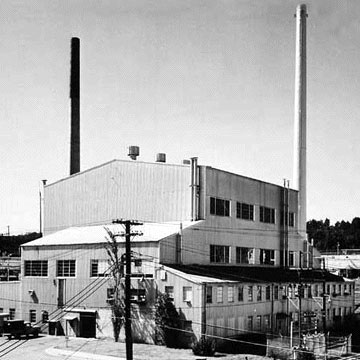
Analysis of the plutonium-239 inside by Jon Schwantes and colleagues
at Pacific Northwest National Laboratory showed that it was refined out
of material from the X-10 reactor in Oak Ridge, Tennessee.
(Image: US Department of Energy)
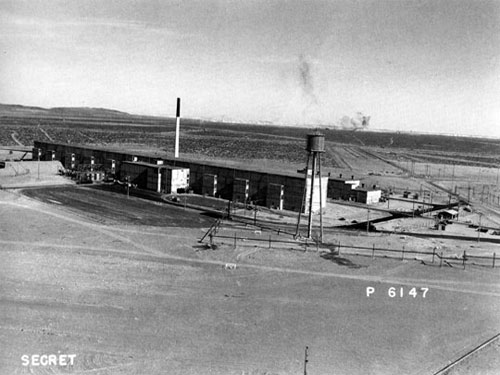
Materials from X-10 were used at Hanford just once, for the inaugural
run of the T-Plant reprocessing facility on 9 December 1944. All the later
plutonium it produced used material sourced at Hanford itself.
(Image: US Department of Energy)
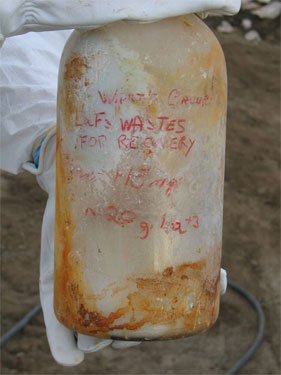
All the evidence indicates that the plutonium-239 in the jar is
some of the very first to be produced at Hanford, and the oldest bulk sample
of weapons grade plutonium in the world.
(Image: Washington Closure Hanford)
|